I believe that reading sample business plans is essential when writing your own.

As you explore business plan examples from real companies and brands, it’s easier for you to learn how to write a good one.
So what does a good business plan look like? And how do you write one that’s both viable and convincing? I’ll walk you through the ideal business plan format along with some examples to help you get started.
Table of Contents
Business Plan Types
Ultimately, the format of your business plan will vary based on your goals for that plan. I’ve added this quick review of different business plan types that achieve differing goals.
For a more detailed exploration of business plan types, you can check out this post.
1. Startups
Startup business plans are for proposing new business ideas. If you’re planning to start a small business, preparing a business plan is crucial. The plan should include all the major factors of your business.
You can check out this guide for more detailed business plan inspiration.
2. Feasibility Studies
Feasibility business plans focus on that business’s product or service. Feasibility plans are sometimes added to startup business plans. They can also be a new business plan for an already thriving organization.
3. Internal Use
You can use internal business plans to share goals, strategies, or performance updates with stakeholders. In my opinion, internal business plans are useful for alignment and building support for ambitious goals.
4. Strategic Initiatives
A strategic business plan is another business plan that’s often shared internally. This plan covers long-term business objectives that might not have been included in the startup business plan.
5. Business Acquisition or Repositioning
When a business is moving forward with an acquisition or repositioning, it may need extra structure and support. These types of business plans expand on a company’s acquisition or repositioning strategy.
6. Growth
Growth sometimes just happens as a business continues operations. But more often, a business needs to create a structure with specific targets to meet set goals for expansion. This business plan type can help a business focus on short-term growth goals and align resources with those goals.
Business Plan Format
I’m going to focus on a startup business plan that needs to be detailed and research-backed as well as compelling enough to convince investors to offer funding. In my experience, the most comprehensive and convincing business plans contain the following sections.
Executive Summary
This all-important introduction to your business plan sets the tone and includes the company description as well as what you will be exchanging for money — whether that’s product lines, services, or product-service hybrids.
Market Opportunity
Information about gaps in your industry’s market and how you plan to fill them, focused on demand and potential for growth.
Competitive Landscape Analysis
An overview of your competitors that includes consideration of their strengths and how you’ll manage them, their weaknesses and how you’ll capitalize on them, and how you can differentiate your offerings in the industry.
Target Audience
Descriptions of your ideal customers, their various problems that you can solve, and your customer acquisition strategy.
Marketing Strategy
This section details how you will market your brand to achieve specific goals, the channels and tactics you’ll utilize to reach those goals, and the metrics you’ll be using to measure your progress.
Key Features and Benefits
This is where you’ll use plain language to emphasize the value of your product/service, how it solves the problems of your target audiences, and how you’ll scale up over time.
Pricing and Revenue
This section describes your pricing strategy and plans for building revenue streams that fit your audiences while achieving your business goals.
Financials
This is the final section, communicating with investors that your business idea is worth investing in via profit/loss statements, cash flow statements, and balance sheets to prove viability.
Sample Business Plan: Section by Section
Okay, so now that we have a format established, I’ll give you more specific details about each section along with examples. Truthfully, I wish I’d had this resource to help me flesh out those first business plans long ago.
1. Executive Summary
I’d say the executive summary is the most important section of the entire business plan. It is essentially an overview of and introduction to your entire project.
Write this in such a way that it grabs your readers’ attention and guides them through the rest of the business plan. This is important because a business plan can be dozens or hundreds of pages long.
There are two main elements I’d recommend including in your executive summary: your company description and your products and services.
Company Description
This is the perfect space to highlight your company’s mission statement and goals, a brief overview of your history and leadership, and your top accomplishments as a business.
Tell potential investors who you are and why what you do matters. Naturally, they’re going to want to know who they’re getting into business with up front. This is a great opportunity to showcase your impact.
Need some extra help firming up your business goals? I’d recommend HubSpot Academy’s free course to help you set meaningful goals that matter most for your business.
Products and Services
Here, you will incorporate an overview of your offerings. This doesn’t have to be extensive, as it is just a chance to introduce your industry and overall purpose as a business. I recommend including snippets of information about your financial projections and competitive advantage here as well.
Keep in mind that you’ll cover many of these topics in more detail later on in the business plan. The executive summary should be clear and brief, only including the most important takeaways.
Executive Summary Business Plan Examples
This example was created with HubSpot’s business plan template. What makes this executive summary good is that it tells potential investors a short story while still covering all of the most important details.
Example 1:
Our Mission
Maria’s Gluten Free Bagels offers gluten-free bagels, along with various toppings, other gluten-free breakfast sandwich items, and coffee. The facility is entirely gluten free. Our team expects to catch the interest of gluten-free, celiac, or health-conscious community members who are seeking an enjoyable cafe to socialize. Due to a lack of gluten-free bagel products in the food industry currently, we expect mild competition and are confident we will be able to build a strong market position.
The Company and Management
Maria’s Gluten Free Bagels was founded in 2010 by Maria Jones, who first began selling her gluten-free bagels online from her home, using social media to spread the word. In 2012 she bought a retail location in Hamilton, MA, which now employs four full-time employees and six part-time employees. Prior to her bagel shop, Maria was a chef in New York and has extensive experience in the food industry.
Along with Maria Jones, Gluten Free Bagel Shop has a board of advisors. The advisors are:
- Jeni King, partner at Winding Communications, Ltd.
- Henry Wilson, president of Blue Robin, LLP.
Our Product
We offer gluten-free products ranging from bagels and cream cheese to blueberry muffins, coffee, and pastries. Our customers are health-conscious, community-oriented people who enjoy gluten-free products. We will create a welcoming, warm environment with opportunities for open mic nights, poetry readings, and other community functions. We will focus on creating an environment in which someone feels comfortable meeting a friend for lunch, or working remotely.
Our Competitive Advantages
While there are other coffee shops and cafes in the North Shore region, there are none that offer purely gluten-free options. This restricts those suffering from gluten-free illnesses or simply those with a gluten-free preference. This will be our primary selling point. Additionally, our market research [see Section 3] has shown a demand for a community-oriented coffee and bagel shop in the town of Hamilton, MA.
Financial Considerations
Our sales projections for the first year are $400,000. We project a 15% growth rate over the next two years. By year three, we project 61% gross margins.
We will have four full-time employees. The salary for each employee will be $50,000.
Start-up Financing Requirements
We are seeking to raise $125,000 in startup to finance year one. The owner has invested $50,000 to meet working capital requirements, and will use a loan of $100,000 to supplement the rest.
Marianne and Keith Bean have been involved with the food industry for several years. They opened their first restaurant in Antlers, Oklahoma in 1981, and their second in Hugo in 1988. Although praised for the quality of many of the items on their menu, they have attained a special notoriety for their desserts. After years of requests for their flavored whipped cream toppings, they have decided to pursue marketing these products separately from the restaurants.
Marianne and Keith Bean have developed several recipes for flavored whipped cream topping. They include chocolate, raspberry, cinnamon almond, and strawberry. These flavored dessert toppings have been used in the setting of their two restaurants over the past 18 years, and have been produced in large quantities. The estimated shelf life of the product is 21 days at refrigeration temperatures and up to six months when frozen. The Beans intend to market this product in its frozen state in 8 and 12-ounce plastic tubs. They also intend to have the products available in six ounce pressurized cans. Special attention has been given to developing an attractive label that will stress the gourmet/specialty nature of the products.
Distribution of Fancy’s Foods Whipped Dream product will begin in the local southeastern Oklahoma area. The Beans have an established name and reputation in this area, and product introduction should encounter little resistance.
Financial analyses show that the company will have both a positive cash flow and profit in the first year. The expected return on equity in the first year is 10.88%
Tips for Writing Your Executive Summary
- Start with a strong introduction of your company that showcases your mission and impact, then outline the products and services you provide.
- Clearly define a problem, explain how your product solves that problem, and show why the market needs your business.
- Be sure to highlight your value proposition, market opportunity, and growth potential.
- Keep it concise and support ideas with data.
- Customize your summary to your audience. For example, you might emphasize finances and return on investment for venture capitalists, whereas you might emphasize community benefits and minimal environmental impact for progressive nonprofits.
For more guidance, check out our tips for writing an effective executive summary.
2. Market Opportunity
This is where you’ll detail the opportunity in the market. Ask and answer: Where is the gap in the current industry, and how will my product fill that gap?
To get a thorough understanding of the market opportunity, you’ll want to conduct a TAM, SAM, SOM analysis, a SWOT analysis, and perform market research on your industry to get some insights for this section. More specifically, here’s what I’d include.
- The size of the market
- Current or potential market share
- Trends in the industry and consumer behavior
- Where the gap is
- What caused the gap
- How you intend to fill it
Market Opportunity Business Plan Example
I like this example because it uses critical data to underline the size of the potential market and what part of that market this service hopes to capture.
Example: The market for Doggie Pause is all of the dog owners in the metropolitan area and surrounding areas of the city. We believe that this is going to be 2/3 of the population, and we have a goal of gaining a 50% market share. We have a target of a 20% yearly profit increase as the business continues.
Tips for Writing Your Market Opportunity Section
- Focus on demand and potential for growth.
- Use market research, surveys, and industry trend data to support your market forecast and projections.
- Add a review of regulation shifts, tech advances, and consumer behavior changes.
- Refer to reliable sources.
- Showcase how your business can make the most of this opportunity.
3. Competitive Landscape Analysis
Since we’re already speaking of market share, you‘ll also need to create a section that shares details on who the top competitors are. After all, your customers likely have more than one brand to choose from, and you’ll want to understand exactly why they might choose one over another.
My favorite part of performing a competitive analysis is that it can help you uncover the following:
- Industry trends that other brands may not be utilizing.
- Strengths in your competition that may be obstacles to handle.
- Weaknesses in your competition that may help you develop selling points.
- The unique proposition you bring to the market that may resonate with customers.
Competitive Landscape Business Plan Example
I like how the competitive landscape section of this business plan shows a clear outline of who the top competitors are. It also highlights specific industry knowledge and the importance of location. This demonstrates useful experience in the industry, helping to build trust in your ability to execute your business plan.
Competitive Environment
Currently, there are four primary competitors in the Greater Omaha Area: Pinot’s Palette Lakeside (franchise partner), Village Canvas and Cabernet, The Corky Canvas, and Twisted Vine Collective. The first three competitors are in Omaha and the fourth is located in Papillion.
Despite the competition, all locations have both public and private events. Each location has a few sold-out painting events each month. The Omaha locations are in new, popular retail locations, while the existing Papillion location is in a downtown business district.
There is an opportunity to take advantage of the environment and open a studio in a well-traveled or growing area. Pinot’s Palette La Vista will differentiate itself from its competitors by offering a premium experience in a high-growth, influential location.
Tips for Writing Your Competitive Landscape
- Complete in-depth research, then emphasize your most important findings.
- Compare your unique selling proposition (USP) to your direct and indirect competitors.
- Show a clear and realistic plan for product and brand differentiation.
- Look for specific advantages and barriers in the competitive landscape. Then, highlight how that information could impact your business.
- Outline growth opportunities from a competitive perspective.
- Add customer feedback and insights to support your competitive analysis.
4. Target Audience
Use this section to describe who your customer segments are in detail. What is the demographic and psychographic information of your audience? I’d recommend building a buyer persona to get in the mindset of your ideal customers and be clear about why you’re targeting them. Here are some questions I’d ask myself:
- What demographics will most likely need/buy your product or service?
- What are the psychographics of this audience? (Desires, triggering events, etc.)
- Why are your offerings valuable to them?
Target Audience Business Plan Example
I like the example below because it uses in-depth research to draw conclusions about audience priorities. It also analyzes how to create the right content for this audience.
The Audience
Recognize that audiences are often already aware of important issues. Outreach materials should:
- Emphasize a pollution-prevention practice
- Tell audience a little about how to prevent pollution
- Tell audience where they can obtain information about prevention.
Message Content
- Focus the content for outreach materials on cost savings, such as when and where pollution prevention is as cheap as or cheaper than traditional techniques. Include facts and figures.
- Emphasize how easy it is to do the right thing and the impacts of not engaging in pollution prevention.
- Stress benefits such as efficiency or better relations with government, for businesses not primarily concerned with public image.
Tips for Writing Your Target Audience Section
- Include details on the size and growth potential of your target audience.
- Figure out and refine the pain points for your target audience, then show why your product is a useful solution.
- Describe your targeted customer acquisition strategy in detail.
- Share anticipated challenges your business may face in acquiring customers and how you plan to address them.
- Add case studies, testimonials, and other data to support your target audience ideas.
- Remember to consider niche audiences and segments of your target audience in your business plan.
5. Marketing Strategy
Here, you‘ll discuss how you’ll acquire new customers with your marketing strategy. I think it’s helpful to have a marketing plan built out in advance to make this part of your business plan easier. I’d suggest including these details:
- Your brand positioning vision and how you’ll cultivate it.
- The goal targets you aim to achieve.
- The metrics you’ll use to measure success.
- The channels and distribution tactics you’ll use.
Marketing Strategy Business Plan Example
This business plan example includes the marketing strategy for the town of Gawler. In my opinion, it works because it offers a comprehensive picture of how they plan to use digital marketing to promote the community.
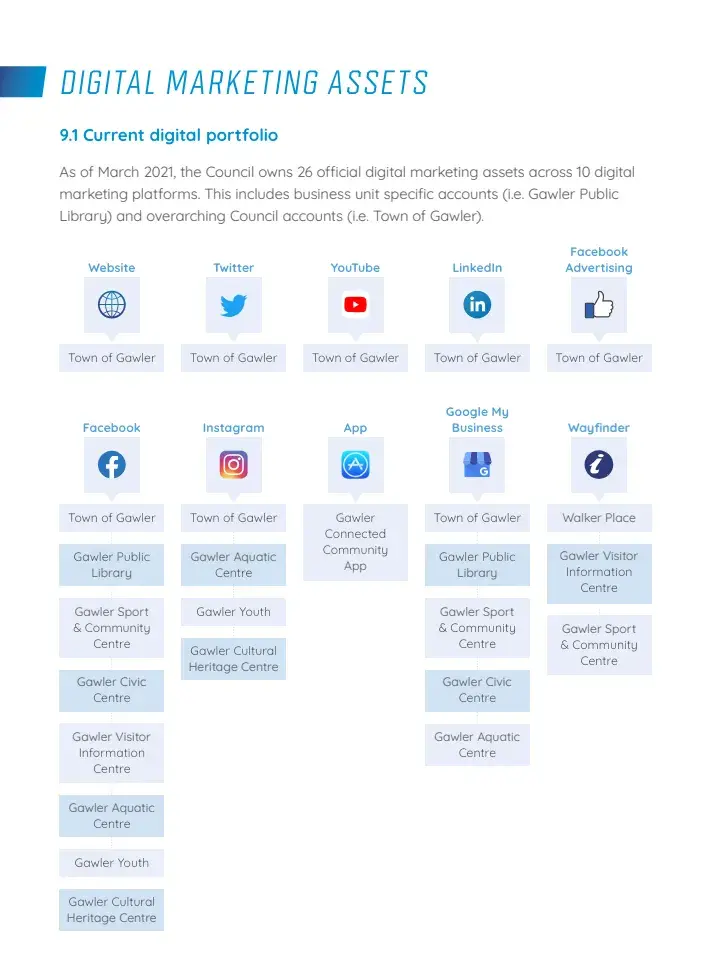
Tips for Writing Your Marketing Strategy
- Include a section about how you believe your brand vision will appeal to customers.
- Add the budget and resources you’ll need to put your plan in place.
- Outline strategies for specific marketing segments.
- Connect strategies to earlier sections like target audience and competitive analysis.
- Review how your marketing strategy will scale with the growth of your business.
- Cover a range of channels and tactics to highlight your ability to adapt your plan in the face of change.
6. Key Features and Benefits
At some point in your business plan, you‘ll need to review the key features and benefits of your products and/or services.
Laying these out can give readers an idea of how you’re positioning yourself in the market and the messaging you’re likely to use. It can even help potential investors gain better insight into your business model.
Key Features and Benefits Business Plan Example
In my opinion, the example below does a great job outlining products and services for this business, along with why these qualities will attract the audience.
Products and Services
The ArtSphere is expanding its offerings. Our primary focus is now on offering art instruction classes. We will tailor our classes according to market segment and time of day, providing instructional opportunities during the morning and mid-day, after-school sessions, and evening classes.
We will have a wide range of art supplies available to complement student sessions as well as for sale to the general public.
Additionally, the owners will continue to show and sell their own work in the Gallery, as well as produce commission portraits and other work.
Tips for Writing Your Key Features and Benefits
- Emphasize why and how your product or service offers value to customers.
- Use metrics and testimonials to support the ideas in this section.
- Talk about how your products and services have the potential to scale.
- Think about including a product roadmap.
- Focus on customer needs, and how the features and benefits you are sharing meet those needs.
- Offer proof of concept for your ideas, like case studies or pilot program feedback.
- Proofread this section carefully, and remove any jargon or complex language.
7. Pricing and Revenue
This is where you’ll discuss your cost structure and various revenue streams. Your pricing strategy must be solid enough to turn a profit while staying competitive in the industry. For this reason, here’s what I’d might outline in this section:
- The specific pricing breakdowns per product or service.
- Why your pricing is higher or lower than your competition’s.
- (If higher) Why customers would be willing to pay more.
- (If lower) How you’re able to offer your products or services at a lower cost.
- When you expect to break even, what margins do you expect, etc?
Pricing and Revenue Business Plan Example
I like how this business plan example begins with an overview of the business revenue model, then shows proposed pricing for key products.
Financial Overview
Revenue Model
Plum generates revenue through the sale of our Plum hardware products, including Plum Lightpad Dimmer, Plum Smart Plug, and Plum Duplex Outlet.
All Plum hardware products are strategically priced at a level that places them significantly below competing products [which retail for an average of $200 or higher] making Plum an accessible home automation option for a broader range of consumer budgets.
Plum Lightpad Dimmer: COGS: $21Wholesale $39Retail: $79
Plum Smart Plug: COGS: $24Wholesale: $43Retail: $84
Tips for Writing Your Pricing and Revenue Section
- Get specific about your pricing strategy. Specifically, how you connect that strategy to customer needs and product value.
- If you are asking a premium price, share unique features or innovations that justify that price point.
- Show how you plan to communicate pricing to customers.
- Create an overview of every revenue stream for your business and how each stream adds to your business model as a whole.
- Share plans to develop new revenue streams in the future.
- Show how and whether pricing will vary by customer segment and how pricing aligns with marketing strategies.
- Restate your value proposition and explain how it aligns with your revenue model.
8. Financials
To me, this section is particularly informative for investors and leadership teams to figure out funding strategies, investment opportunities, and more. While some business plans might include more or less information, according to Forbes you’ll want to include three main details:
- Profit/Loss Statement. This answers the question of whether your business is currently profitable.
- Cash Flow Statement. This details exactly how much cash is incoming and outgoing to give insight into how much cash a business has on hand.
- Balance Sheet. This outlines assets, liabilities, and equity, which gives insight into how much a business is worth.
Financials Business Plan Example
This balance sheet is a great example of the level of detail you’ll need to include in the financials section of your business plan.
Assets
Current Assets
1000 Cash
1010 Checking 583,961
1020 Savings 224,600
1030 Petty Cash 89,840
Total Cash – 898,402
1100 Accounts Receivable – 3,593,607
1200 Work in Process – 589,791
1300 Other Current Assets
1310 Prepaid Rent 164,593
1320 Prepaid Liability Insurance 109,728
Total Other Current Assets – 274,321
Total Current Assets – 5,356,121
Tips for Writing Your Financials Section
- Growth potential is important in this section too. Using your data, create a forecast of financial performance in the next three to five years.
- Include any data that supports your projections to assure investors of the credibility of your proposal.
- Add a break-even analysis to show that your business plan is financially practical. This information can also help you pivot quickly as your business grows.
- Consider adding a section that reviews potential risks and how sensitive your plan is to changes in the market.
- Triple-check all financial information in your plan for accuracy.
- Show how any proposed funding needs align with your plans for growth.
Sample Business Plan Templates
Now that you know what‘s included and how to format a business plan, let’s review some of my favorite templates.
1. HubSpot’s One-Page Business Plan
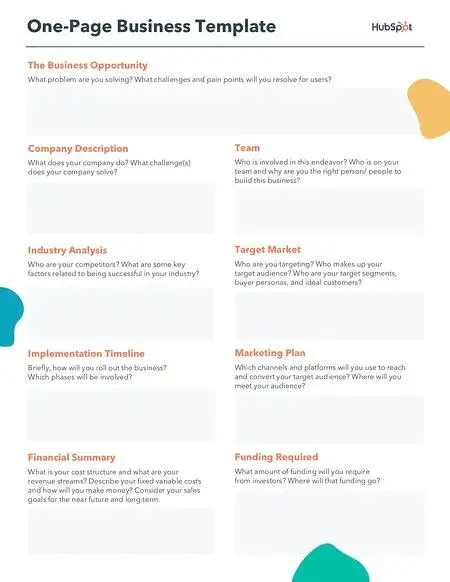
Download a free, editable one-page business plan template.
The business plan linked above was created here at HubSpot and is perfect for businesses of any size — no matter how many strategies we still have to develop.
Fields such as Company Description, Required Funding, and Implementation Timeline give this one-page business plan a framework for how to build your brand and what tasks to keep track of as you grow.
Then, as the business matures, you can expand on your original business plan with a new iteration of the above document.
Why I Like It
This one-page business plan is a fantastic choice for the new business owner who doesn’t have the time or resources to draft a full-blown business plan. It includes all the essential sections in an accessible, bullet-point-friendly format. That way, you can get the broad strokes down before honing in on the details.
2. HubSpot’s Downloadable Business Plan Template
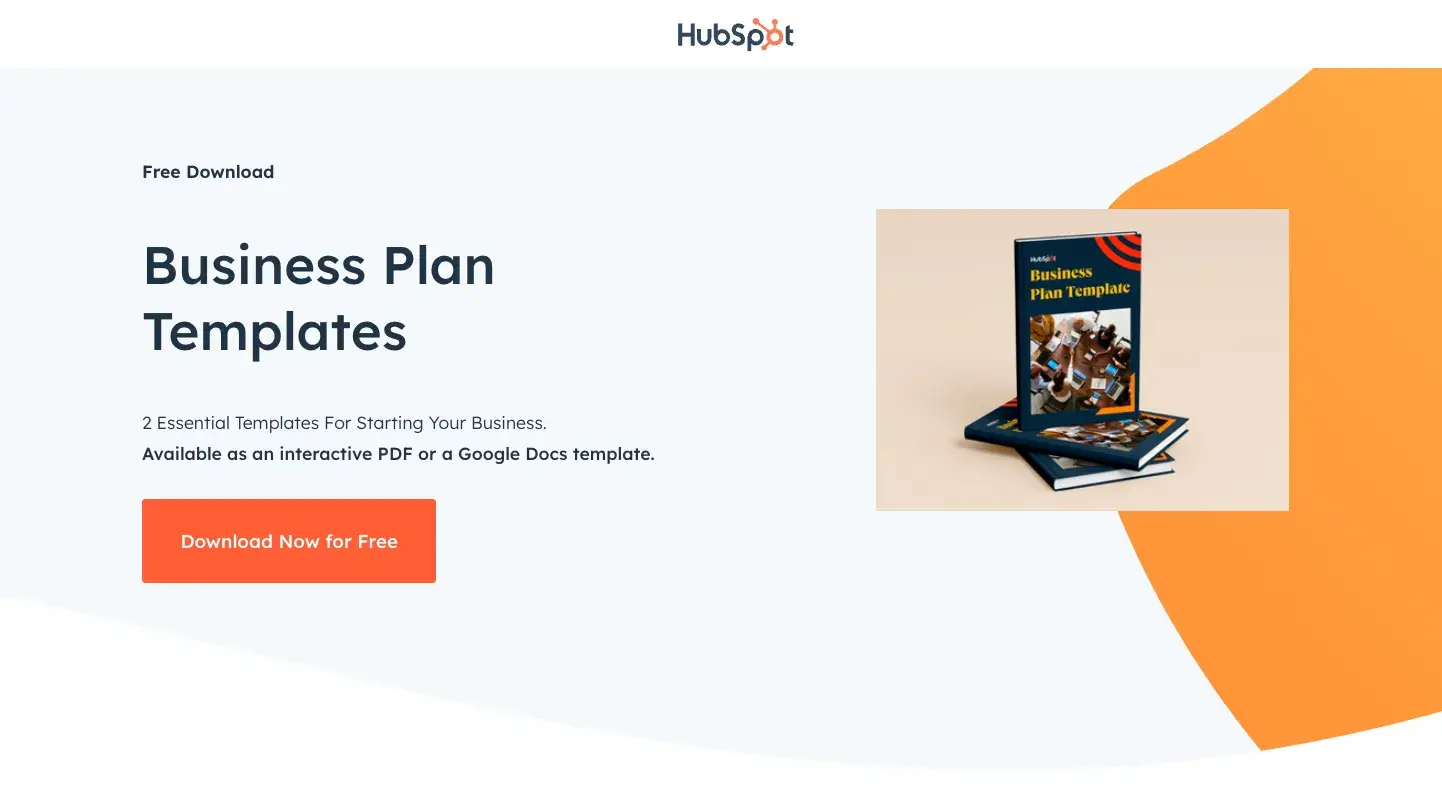
We also created a business plan template for entrepreneurs.
Download a free, editable one-page business plan template.
The template is designed as a guide and checklist for starting your own business. You’ll learn what to include in each section of your business plan and how to do it.
There’s also a list for you to check off when you finish each section of your business plan.
Strong game plans help coaches win games and help businesses rocket to the top of their industries. So if you dedicate the time and effort required to write a workable and convincing business plan, you’ll boost your chances of success and even dominance in your market.
Why I Like It
This business plan kit is essential for the budding entrepreneur who needs a more extensive document to share with investors and other stakeholders.
It not only includes sections for your executive summary, product line, market analysis, marketing plan, and sales plan, but it also offers hands-on guidance for filling out those sections.
3. LiveFlow’s Financial Planning Template with built-in automation
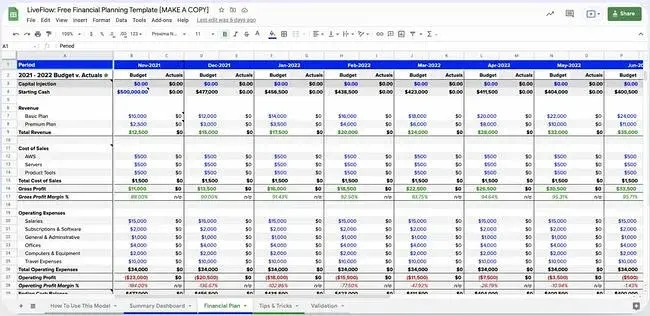
This free template from LiveFlow aims to make it easy for businesses to create a financial plan and track their progress on a monthly basis.
The P&L Budget versus Actual format allows users to track their revenue, cost of sales, operating expenses, operating profit margin, net profit, and more.
The summary dashboard aggregates all of the data put into the financial plan sheet and will automatically update when changes are made.
Instead of wasting hours manually importing your data to your spreadsheet, LiveFlow can also help you to automatically connect your accounting and banking data directly to your spreadsheet, so your numbers are always up-to-date.
With the dashboard, you can view your runway, cash balance, burn rate, gross margins, and other metrics. Having a simple way to track everything in one place will make it easier to complete the financials section of your business plan.
Why I Like It
This is a fantastic template to track performance and alignment internally and to create a dependable process for documenting financial information across the business. It’s highly versatile and beginner-friendly.
It’s especially useful if you don’t have an accountant on the team. (I always recommend you do, but for new businesses, having one might not be possible.)
4. ThoughtCo’s Sample Business Plan
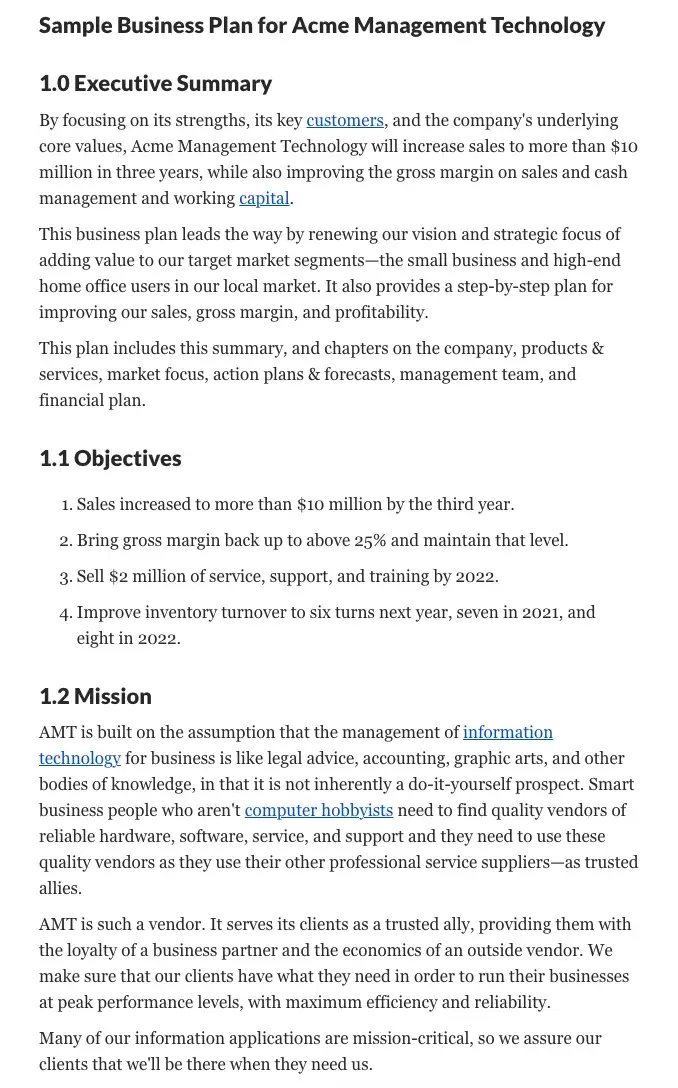
If you want to reference an actual business plan while writing your own, ThoughtCo has got you covered. It created a fictional company called Acme Management Technology and wrote an entire business plan for it.
Using its sample business plan as a guide while filling out your own will help you catch and include small yet important details in your business plan that you otherwise might not have noticed.
Why I Like It
This is a fantastic template for an existing business that’s strategically shifting directions. If your company has been around for a while, and you’re looking to improve your bottom line or revitalize your strategy, this is an excellent template to use and follow.
5. BPlan’s Free Business Plan Template
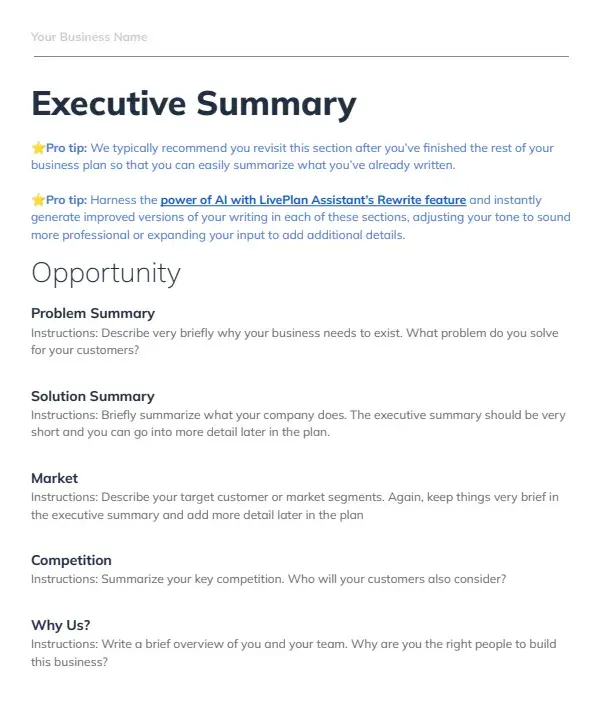
One of the more financially oriented sample business plans in this list, BPlan’s free business plan template dedicates many of its pages to your business’s financial plan and financial statements.
After filling this business plan out, your company will truly understand its financial health and the steps you need to take to maintain or improve it.
Why I Like It
I absolutely love this business plan template because of its ease-of-use and hands-on instructions (in addition to its finance-centric components). If you feel overwhelmed by the thought of writing an entire business plan, consider using this template to help you with the process.
6. Harvard Business Review’s “How to Write a Winning Business Plan”
Most sample business plans teach you what to include in your business plan, but this Harvard Business Review article will take your business plan to the next level — it teaches you the why and how behind writing a business plan.
With the guidance of Stanley Rich and Richard Gumpert, co-authors of “Business Plans That Win: Lessons From the MIT Enterprise Forum“, you’ll learn how to write a convincing business plan that emphasizes the market demand for your product or service.
You’ll also learn the financial benefits investors can reap from putting money into your venture rather than trying to sell them on how great your product or service is.
Why I Like It
This business plan guide focuses less on the individual parts of a business plan, and more on the overarching goal of writing one. For that reason, it’s one of my favorites to supplement any template you choose to use. Harvard Business Review’s guide is instrumental for both new and seasoned business owners.
7. HubSpot’s Complete Guide to Starting a Business
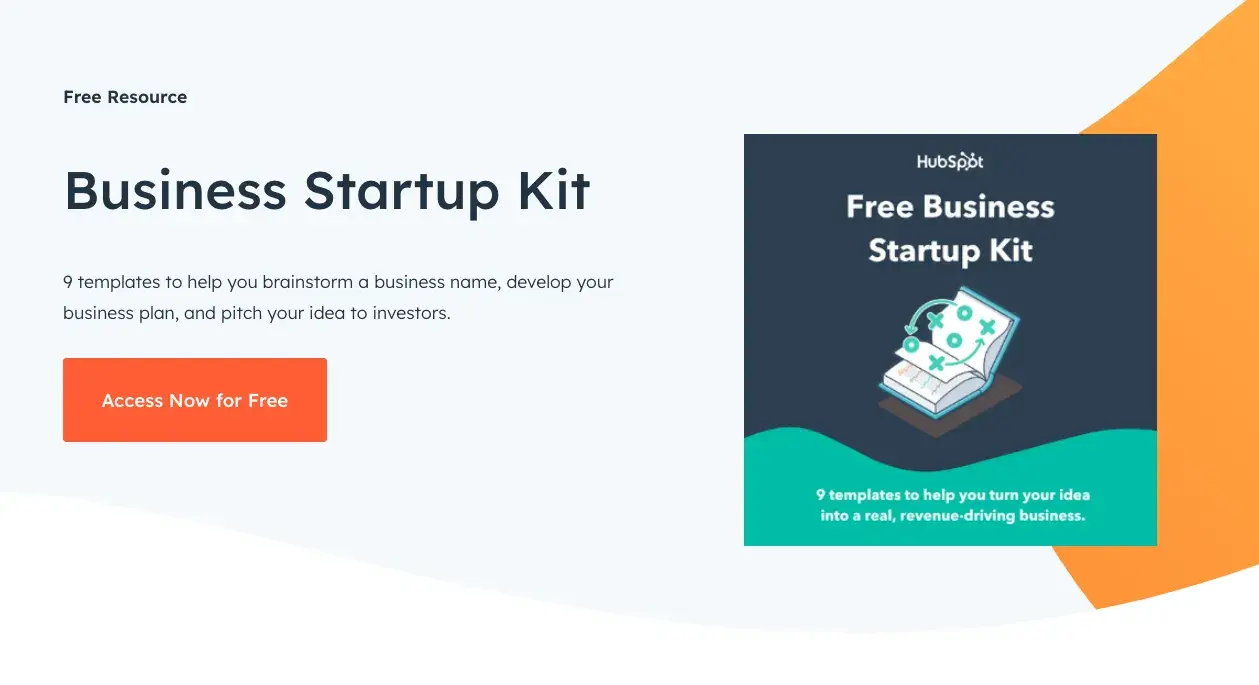
If you’re an entrepreneur, you know writing a business plan is one of the most challenging first steps to starting a business.
Fortunately, with HubSpot‘s comprehensive guide to starting a business, you’ll learn how to map out all the details by understanding what to include in your business plan and why it’s important to include them. The guide also fleshes out an entire sample business plan for you.
If you need further guidance on starting a business, HubSpot’s guide can teach you how to make your business legal, choose and register your business name, and fund your business. It will also give small business tax information and includes marketing, sales, and service tips.
Why I Like It
This comprehensive guide will walk you through the process of starting a business — including writing your business plan — with a high level of exactitude and detail. It also offers other resources you might need, such as market analysis templates. So if you’re in the midst of starting your business, this is an excellent guide for you.
Since writing this article, there’s now an amazing suite of products available for new business builders called HubSpot Starter.
It’s essential for businesses trying to get their plan in motion, giving you all the tools you need to build your brand online. It can be a huge help in finding critical information to build out your business plan with realistic numbers — among many other benefits — and I highly recommend it.
8. Panda Doc’s Free Business Plan Template
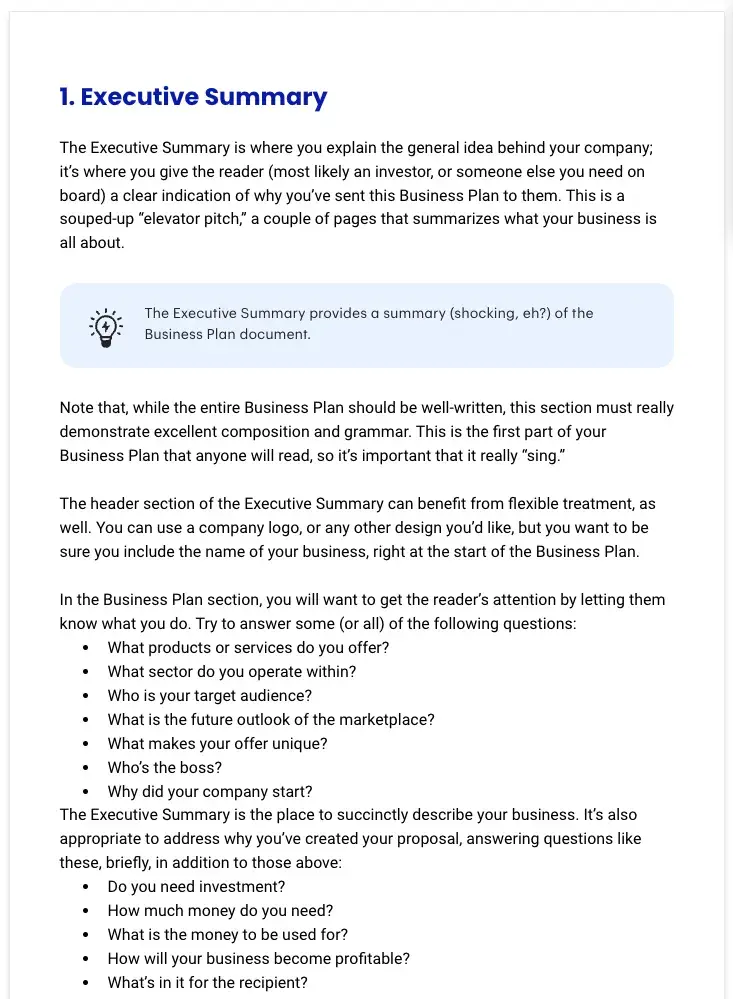
PandaDoc’s free business plan template is one of the more detailed and fleshed-out sample business plans on this list. It describes what you should include in each section, so you don’t have to come up with everything from scratch.
Once you fill it out, you’ll fully understand your business’ nitty-gritty details and how all of its moving parts should work together to contribute to its success.
Why I Like It
This template has two things I love: comprehensiveness and in-depth instructions. Plus, it’s synced with PandaDoc’s e-signature software so that you and other stakeholders can sign it with ease. For that reason, I especially love it for those starting a business with a partner or with a board of directors.
9. Small Business Administration Free Business Plan Template
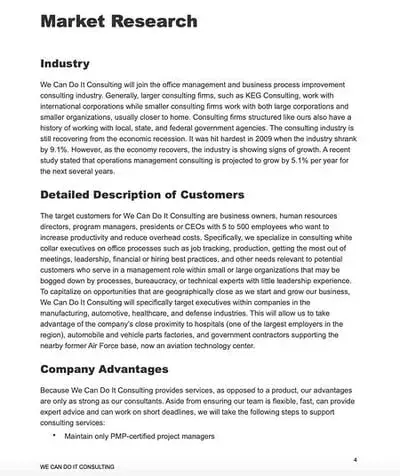
The Small Business Administration (SBA) offers several free business plan templates that can be used to inspire your own plan.
Before you get started, you can decide what type of business plan you need — a traditional or lean start-up plan.
Then, you can review the format for both of those plans and view examples of what they might look like.
Why I Like It
We love both of the SBA’s templates because of their versatility. You can choose between two options and use the existing content in the templates to flesh out your own plan. Plus, if needed, you can get a free business counselor to help you along the way.
Top Business Plan Examples
I’ve compiled some completed business plan samples to help you get an idea of how to customize a plan for your business.
I chose different types of business plan ideas to expand your imagination. Some are extensive, while others are fairly simple.
Let’s take a look.
1. LiveFlow
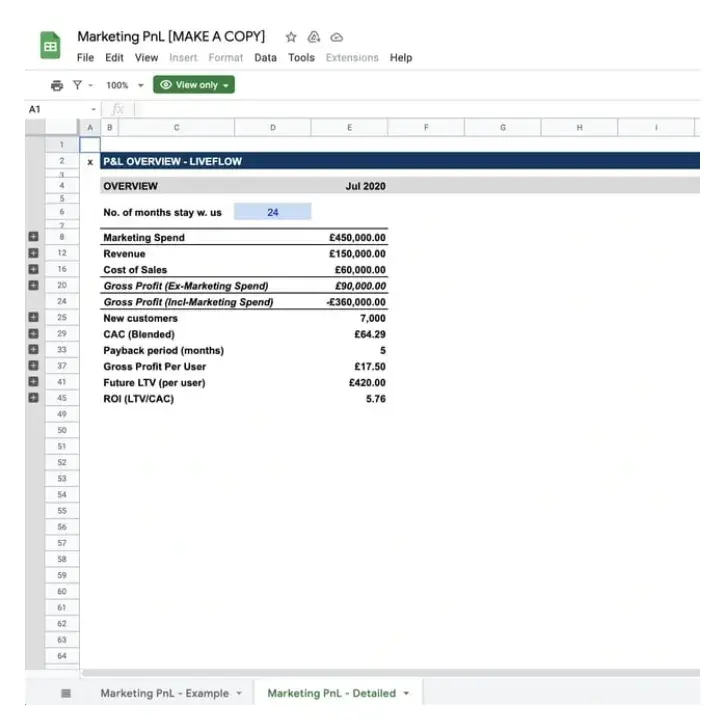
One of the major business expenses is marketing. How you handle your marketing reflects your company’s revenue.
I included this business plan to show you how you can ensure your marketing team is aligned with your overall business plan to get results. The plan also shows you how to track even the smallest metrics of your campaigns, like ROI and payback periods instead of just focusing on big metrics like gross and revenue.
Fintech startup, LiveFlow, allows users to sync real-time data from its accounting services, payment platforms, and banks into custom reports. This eliminates the task of pulling reports together manually, saving teams time and helping automate workflows.
“Using this framework over a traditional marketing plan will help you set a profitable marketing strategy taking things like CAC, LTV, Payback period, and P&L into consideration,” explains LiveFlow co-founder, Lasse Kalkar.
Why I Like It
When it came to including marketing strategy in its business plan, LiveFlow created a separate marketing profit and loss statement (P&L) to track how well the company was doing with its marketing initiatives.
This is a great approach, allowing businesses to focus on where their marketing dollars are making the most impact. Having this information handy will enable you to build out your business plan’s marketing section with confidence. LiveFlow has shared the template here. You can test it for yourself.
2. Lula Body
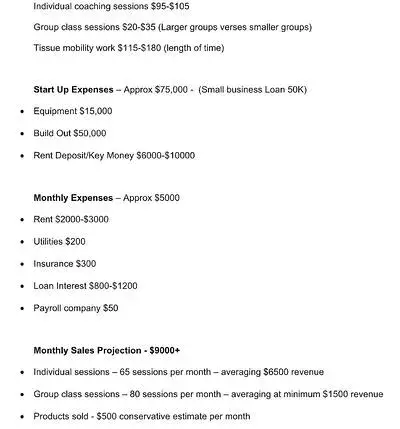
Brooklyn Business owner and Pilates instructor, Tara Kashyap, saw a need in her community for a Pilates, tissue, and bodywork studio. In response, she opened Lula Body in Crown Heights.
Pictured above is a hypothetical pricing and revenue statement based on Lula Body’s business plan. As you can see, Kashyap breaks down the cost of classes, start-up expenses, monthly expenses, and her monthly sales projection.
Everything from equipment costs to loan interest is included in the expenses to give the most accurate picture of operating costs and revenue.
If you’re seeking outside funding for your business, you’ll want to make sure this section of your business plan is as thorough as possible.
Why I Like It
This is a good business plan example for service-based businesses such as gyms, boxing classes, dancing studios, etc. For starters, the plan shows how to budget for the business loan and what to focus on buying first.
Everything is well presented, including what to charge the customers in different scenarios and the expected revenue. This is a good foundation from which business performance can be evaluated with time.
3. Patagonia

Sometimes all you need is a solid mission statement and core values to guide you on how to go about everything. You do this by creating a business plan revolving around how to fulfill your statement best.
For example, Patagonia is an eco-friendly company, so their plan discusses how to make the best environmentally friendly products without causing harm.
A good mission statement should not only resonate with consumers but should also serve as a core value compass for employees as well.
Why I Like It
Patagonia has one of the most compelling mission statements I’ve seen:
“Together, let’s prioritize purpose over profit and protect this wondrous planet, our only home.”
It reels you in from the start, and the environmentally friendly theme continues throughout the rest of the statement.
This mission goes on to explain that they are out to “Build the best product, cause no unnecessary harm, and use business to protect nature.”
Their mission statement is compelling and detailed, with each section outlining how they will accomplish their goal.
4. Vesta Home Automation
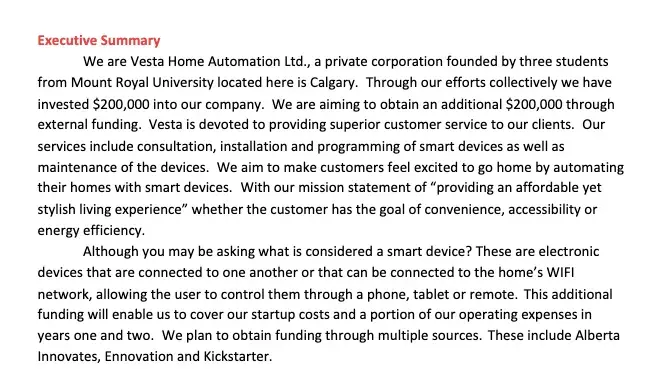
This executive summary for a smart home device startup is part of a business plan created by students at Mount Royal University.
While it lacks some of the sleek visuals of the templates above, its executive summary does a great job of demonstrating how invested they are in the business.
Right away, they mention they’ve invested $200,000 into the company already, which shows investors they have skin in the game and aren’t just looking for someone else to foot the bill.
Why I Like It
This is the kind of business plan you need when applying for business funds. It clearly illustrates the expected future of the company and how the business has been coming along over the years.
5. NALB Creative Center
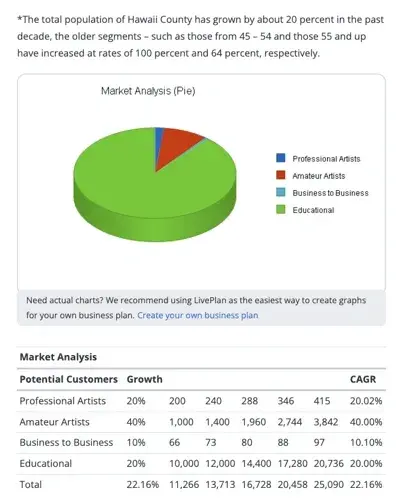
This fictional business plan for an art supply store includes everything one might need in a business plan: an executive summary, a company summary, a list of services, a market analysis summary, and more.
One of its most notable sections is its market analysis summary, which includes an overview of the population growth in the business’ target geographical area, as well as a breakdown of the types of potential customers they expect to welcome at the store.
This sort of granular insight is essential for understanding and communicating your business’s growth potential. Plus, it lays a strong foundation for creating relevant and useful buyer personas.
It’s essential to keep this information up-to-date as your market and target buyer changes. For that reason, you should carry out market research as often as possible to ensure that you’re targeting the correct audience and sharing accurate information with your investors.
Why I Like It
Due to its comprehensiveness, it’s an excellent example to follow if you’re opening a brick-and-mortar store and need to get external funding to start your business.
6. Curriculum Companion Suites (CCS)

If you’re looking for a SaaS business plan example, look no further than this business plan for a fictional educational software company called Curriculum Companion Suites.
Like the business plan for the NALB Creative Center, it includes plenty of information for prospective investors and other key stakeholders in the business.
One of the most notable features of this business plan is the executive summary, which includes an overview of the product, market, and mission.
The first two are essential for software companies because the product offering is so often at the forefront of the company’s strategy. Without that information being immediately available to investors and executives, then you risk writing an unfocused business plan.
Why I Like It
It’s essential to front-load your company’s mission if it explains your “Why?” and this example does just that. In other words, why do you do what you do, and why should stakeholders care? This is an important section to include if you feel that your mission will drive interest in the business and its offerings.
7. Culina Sample Business Plan
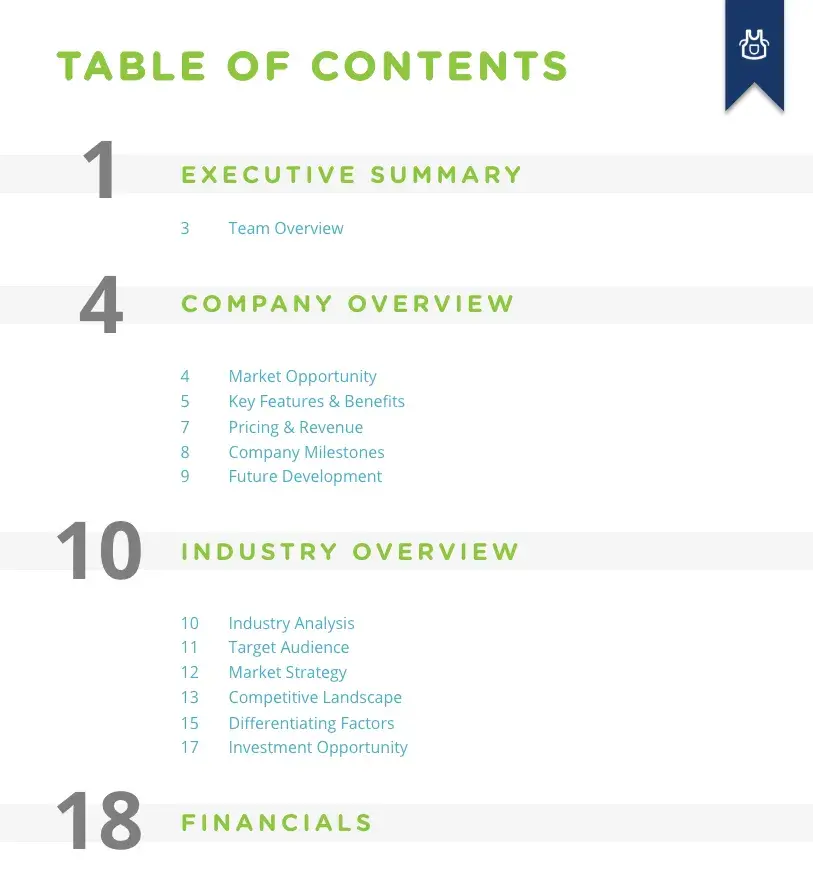
Culina’s sample business plan is an excellent example of how to lay out your business plan so that it flows naturally, engages readers, and provides the critical information investors and stakeholders need.
Why I Like It
You can use this template as a guide while you‘re gathering important information for your own business plan. You’ll have a better understanding of the data and research you need to do since Culina’s plan outlines these details so flawlessly for inspiration.
8. Plum Sample Business Plan
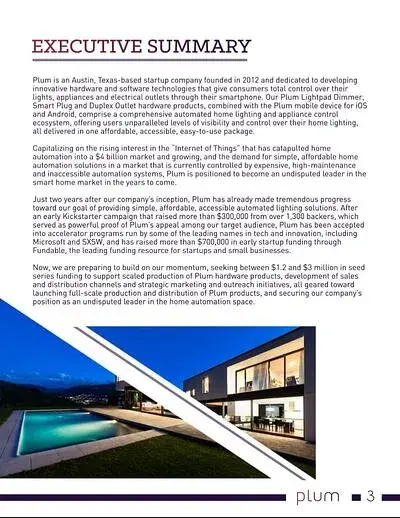
When creating your own business plan, make sure the pictures and design you use make sense for your branding. The images in this plan are cutting-edge, which makes sense for an innovative company like Plum.
Why I Like It
This is one of my favorite sample business plans because you can see how implementing visuals can help tell your brand‘s story. Additionally, the financial charts included are an excellent guide if you’re not sure what financial information to include.
9. LiveShopBuy Sample Business Plan
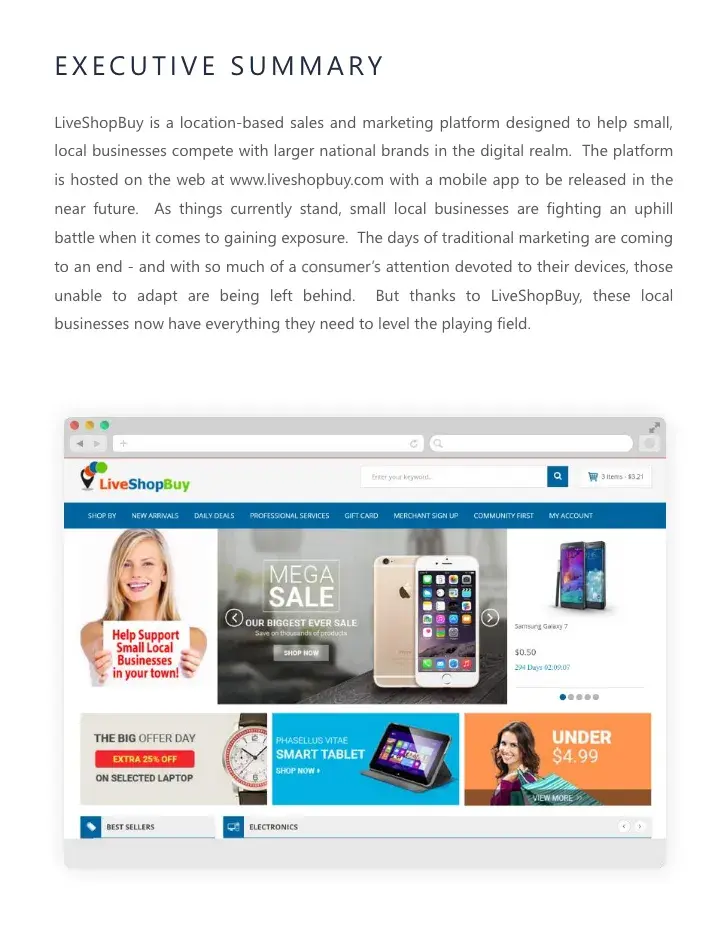
With this business plan, the focus is the investment opportunity. This is an excellent template to use if you’re going to use your business plan to seek funding.
Why I Like It
The investment opportunity section is placed right up front and is several pages long. Then, it goes into more detail about the company and its key services. Nice.
Get Started Writing Your Business Plan
When you’re first getting started on your business plan, I know it can be daunting. The business world moves fast, and it’s full of ambitious companies scrambling to gain the majority of their industry’s market share.
That‘s why it’s important to make sure you understand the value your business offers and can communicate that through a properly formatted business plan.
Editor’s note: This post was originally published in November 2018 and has been updated for comprehensiveness. This article was written by a human, but our team uses AI in our editorial process. Check out our full disclosure to learn more about how we use AI.


![HubSpot’s 2025 State of Blogging Report [Data from 500+ Marketers]](https://bloggerseo.com.ng/wp-content/uploads/2025/01/hubspots-2025-state-of-blogging-report-data-from-500-marketers-150x59.png)





